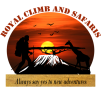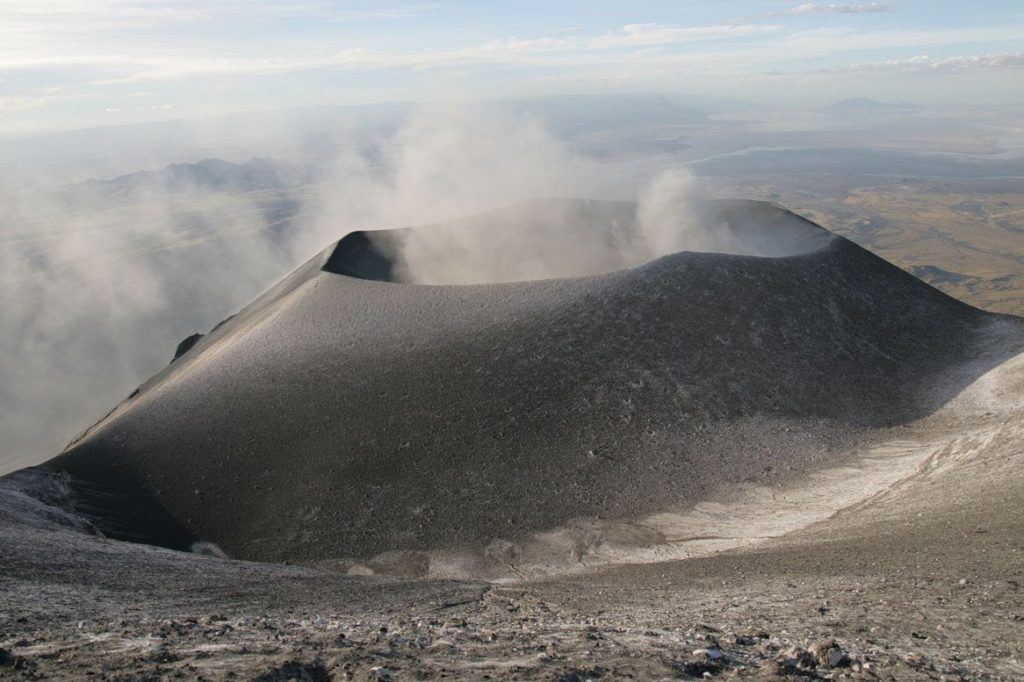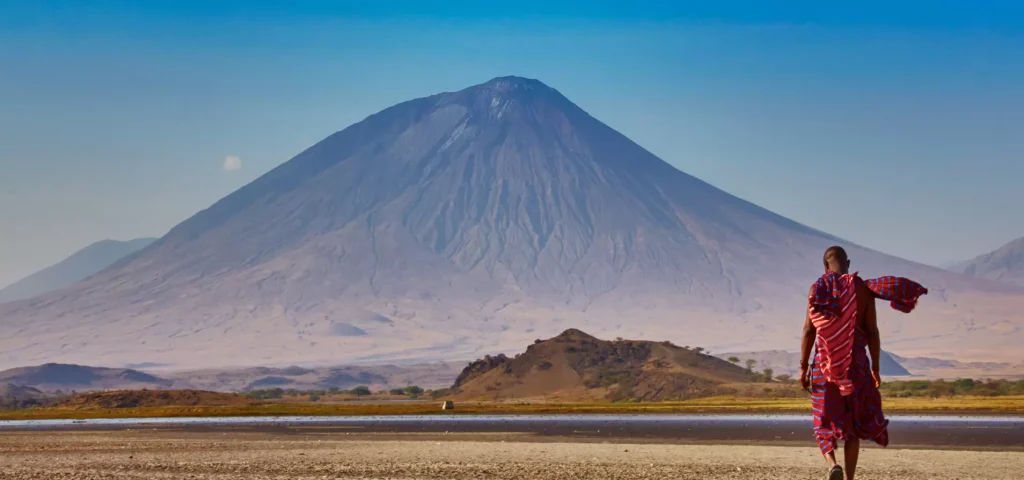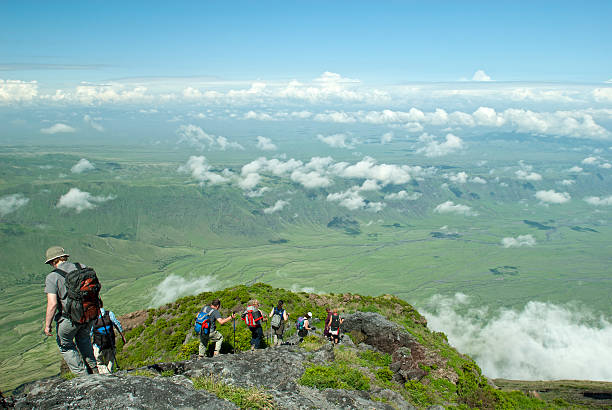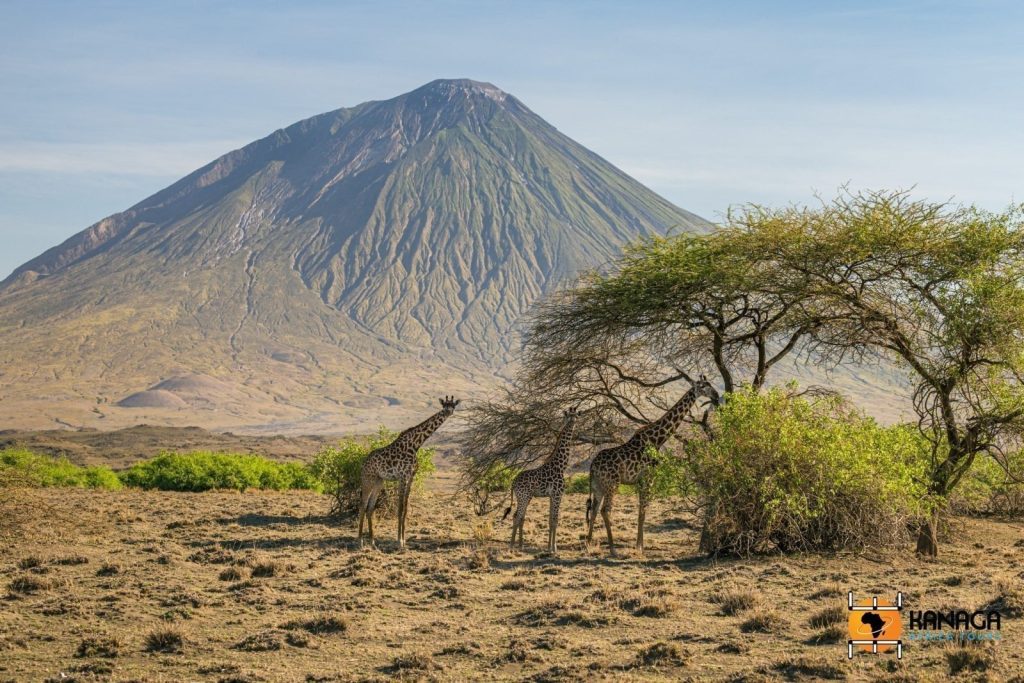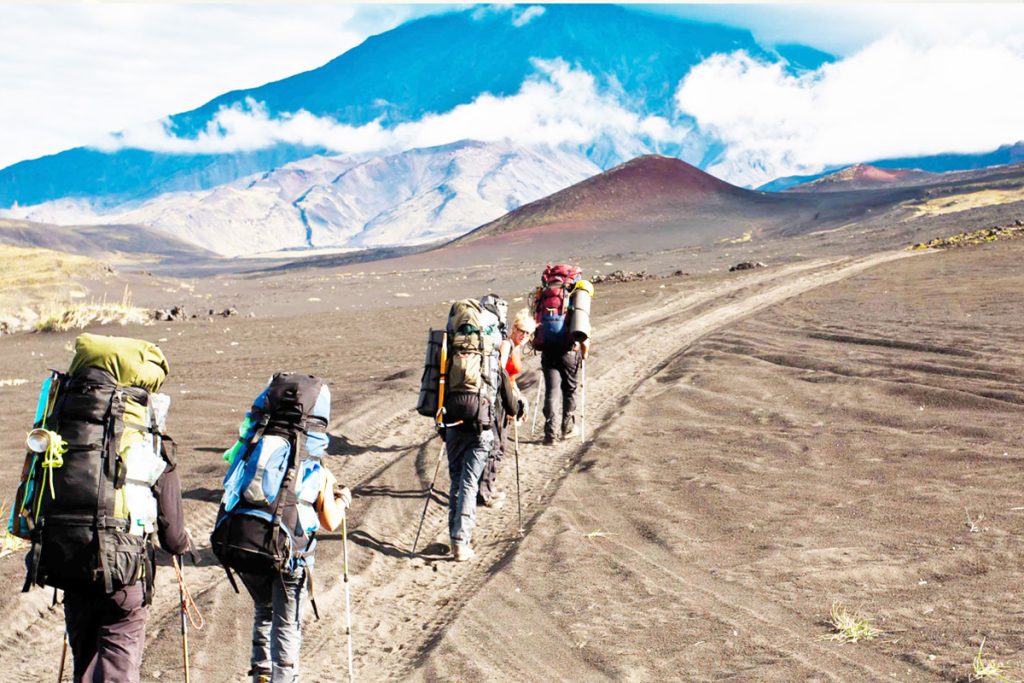Ol Doinyo Lengai Climbing Tour
Ol Doinyo Lengai volcano is situated in one of the beautiful places of North Tanzania, near Lake Natron where hundreds of thousands of pink flamingos fly every year. Ol Doinyo Lengai is unique among active volcanoes in the East Africa and unique in the world which produces natrocarbonatite lava or “cold lava”. It has a dark-brown or black color in liquid state and a fluidity as water. This temperature is much lower than other lavas but, however, not so cool because it is approximately 510-600°C. In a hundred years Lengai has erupted about 15 times, the last time was in 2013. Fortunately, Ol Doinyo Lengai eruptions happen without victims because the volcano has relatively small size and it is situated rather far from nearest Maasai villages.
Duration: 2 or 3 days
Itinerary
Day 1: ARUSHA – LAKE NATRON
Our driver will pick you up at your hotel in the morning and drive you to Lake Natron. The drive is fairly long and you will reach Lake Natron Camp some time after lunch. At the same time, the scenery on the way is picturesque and you will have an opportunity to see the local people, including Maasai tribesmen, as well as some African wildlife. After your check-in a guide will take you on a walking tour to Ngare Sero waterfall. The trail runs through a gorge and you will sometimes need to ford the stream, so we recommend that you wear sandals or the like to avoid constantly having to take your shoes off. A drive to the lakeshore, where you get a chance to capture its great scenery on camera takes place before you return to the Lodge for dinner and some rest.
Day 2: TREKKING TO OL DOINYO LENGAI VOLCANO – ARUSHA
At 11:00 pm. driver takes you to the foot of Ol Doinyo Lengai volcano for the start of your climb. The footing on the slopes of the volcano can be treacherous, especially in the dark, so follow your guide without overtaking him. The trek is strenuous and takes between 7 and 12 hours depending on your fitness and resultant pace. The gradient is steep, so it is best to make a short stop with every 100 m or so of altitude gained in order to get acclimatized.
It is best to make a break for breakfast on the way to the top in order to regain some strength for the remainder of your Ol Doinyo Lengai climb. At the edge of the crater you will have reached the altitude of 2,960 m. Here, you can actually hear the Ol Doinyo Lengai lava flow inside the crator of the “Mountain of God”. The descent is easier and you may be tempted to move faster. This is, however, the time when most injuries happen, so mind your step! It is also advisable to change your fleece for a sun hat after dawn in order to avoid heatstroke.
Our driver will be awaiting you as you return to the foot of the mountain with cold drinks, ready to drive you back to the camp for a quick shower and lunch before your return to Arusha.

INCLUDED IN THE TREKKING PACKAGE:
- 2Permission for the ascent;
- Fees of local communities on Lake Natron;
- Accommodation in Lake Natron Camp (full board and drinks);
- Day-use at Lake Natron Camp on the day of descent from Lengai (room and lunch);
- Land Cruiser 4×4 with a pop-up roof, ergonomic seats, binoculars, fridge for drinks
- Experienced English-speaking safari guide for safari on Lake Natron;
- Services of Maasai guide for the climb to the top of Lengai;
- Packed breakfast during Lengai climb (carried by you);
- Drinking water during Lengai climb (carried by you);
- Optional tour to the Ngare Sero waterfall.
- First aid kit
EXCLUDED FROM TREKKING PACKAGE:
- Airport transfers;
- Accommodation in Arusha before and after the climb;
- Services of porters during the climb;
- Tips for guide
Private Trek
Please find below the prices for organizing a private trek. The prices are based on your group size.
Solo Trekker – USD 1300 per person
Group of 2 – 4 USD 980 per person
Group of 5 – 9 USD 750 per person
Group of 10+ USD 600 per person
Prices quoted are subject to current Government Regulated Park Fees at the time of departure
Payment Terms
Deposit Payment
The deposit is 20% of the total booking amount.
Deposit can be paid either via a bank transfer or an online card payment.
We offer bank accounts in USD currencies for bank transfers.
Once you make the advance payment you will receive a booking confirmation.
Balance Payment
Balance can
be paid via bank transfer or with cash.
Bank payment can be made 15 days before the tour date (recommended 30 days prior).
Cash can be paid on arrival (USD printed in or after the year 2009).
Cancellation Policy
8 days and above departure
No cancellation fees.
0 to 7 days before departure
50% of the total tour price will be charged as cancellation fees.
Trek can be postponed to any new date without any extra cost at any point in time.
The 5% surcharge paid for either or both advance and balance payments is non-refundable in case of cancellation of the trek.
Frequently Asked Questions (FAQ) – Mount Kilimanjaro Trek & Arrival in Tanzania
Whether you’re planning your first Kilimanjaro trek or are a seasoned adventurer, it’s common to have questions about the journey and logistics. Here’s a comprehensive list of FAQs to help you prepare for your Mount Kilimanjaro trek and arrival in Tanzania.
General Questions about Kilimanjaro Trekking
1. What is the best time to climb Mount Kilimanjaro?
- The best months for trekking Kilimanjaro are during the dry seasons, from June to October and December to February. These months offer the best weather conditions for a successful and enjoyable trek.
2. How fit do I need to be to climb Kilimanjaro?
- Kilimanjaro is non-technical but physically demanding. You should be in good physical condition with a focus on cardio fitness, strength training, and endurance. Prepare by hiking and increasing your stamina before the trek.
3. Which route is the best for climbing Kilimanjaro?
- Lemosho Route is highly recommended for its scenic beauty, lower crowd levels, and excellent acclimatization profile, making it ideal for first-time climbers. Other popular routes include the Machame and Rongai routes.
4. What is the success rate of reaching the summit?
- The summit success rate on longer routes like the 8-day Lemosho Route is around 90%, as it allows for better acclimatization compared to shorter routes.
5. What is the altitude of Uhuru Peak?
- Uhuru Peak, the summit of Mount Kilimanjaro, stands at 5,895 meters (19,341 feet) above sea level.
6. How many days does it take to climb Kilimanjaro?
- Most itineraries range from 6 to 8 days. The 8-day Lemosho Route is highly recommended as it provides the best balance of time for acclimatization and success.
7. Do I need a guide to climb Kilimanjaro?
- Yes, it is mandatory to have a licensed guide. Royal Climb and Safaris provides professional, experienced guides for all Kilimanjaro treks.
8. How cold does it get on Kilimanjaro?
- Temperatures vary depending on the altitude. At the summit, night temperatures can drop to -20°C (-4°F), so you’ll need appropriate cold-weather gear.
9. Will I experience altitude sickness?
- Altitude sickness is a possibility on Kilimanjaro. Symptoms can include headaches, nausea, and shortness of breath. Our guides monitor your condition daily to ensure safe acclimatization. Drinking plenty of water and trekking slowly (“pole pole”) can help prevent symptoms.
10. What do I eat during the trek?
- You’ll be provided with nutritious meals throughout the trek, including soups, pasta, rice, vegetables, and protein. Special dietary requirements can be accommodated with advance notice.
Packing and Gear Questions
11. What equipment do I need for the Kilimanjaro trek?
- Essential items include a good-quality sleeping bag, trekking boots, warm clothing, rain gear, and a headlamp. A complete gear list will be provided when booking with Royal Climb and Safaris, and gear rental is available.
12. Can I rent equipment for Kilimanjaro?
- Yes, equipment like sleeping bags, trekking poles, and down jackets can be rented upon arrival.
13. How much weight do the porters carry?
- Porters carry up to 15 kg of your gear. You will carry a daypack with essentials like water, snacks, and extra clothing layers.
Arrival in Tanzania and Logistics
14. Do I need a visa to enter Tanzania?
- Most travelers require a visa to enter Tanzania. Visas can be obtained on arrival at Kilimanjaro International Airport (JRO) or online via the Tanzania eVisa system.
15. Which airport should I fly into?
- Kilimanjaro International Airport (JRO) is the nearest airport to Mount Kilimanjaro. It’s located between Arusha and Moshi, both of which are starting points for your trek.
16. What vaccinations are required for Tanzania?
- It’s recommended to have vaccinations for yellow fever, hepatitis A and B, typhoid, and tetanus. Check with your local travel clinic for any other requirements, especially if you’re arriving from a yellow fever-endemic country.
17. Do I need travel insurance for the trek?
- Yes, it is highly recommended to have comprehensive travel insurance that covers high-altitude trekking, emergency medical evacuation, and trip cancellations.
18. How do I get from the airport to the hotel?
- Royal Climb and Safaris provides airport transfers to and from Kilimanjaro International Airport. Our driver will meet you at the airport and transport you to your hotel for rest before your trek.
19. Where should I stay before and after the trek?
- Most trekkers stay in Moshi or Arusha before and after the trek. Royal Climb and Safaris can recommend comfortable hotels with all the amenities to help you relax before and after your climb.
Booking and Payment Questions
20. How far in advance should I book my Kilimanjaro trek?
- It’s best to book at least 3 to 6 months in advance to ensure availability and time for proper preparation.
21. What payment methods are accepted?
- Royal Climb and Safaris accept bank transfers, major credit cards, and cash payments (USD, or Tanzanian Shillings).
22. Are tips expected?
- Yes, tipping is customary after a successful trek. You can tip your guides, porters, and cooks at the end of the climb. We recommend a total tip of around $200-$300 per climber, which is shared among the team.
Miscellaneous Questions
23. Is Wi-Fi available in Kilimanjaro?
- There is no reliable Wi-Fi on the mountain, though mobile network coverage is available at certain points, especially lower down. It’s best to focus on disconnecting and enjoying the trek!
24. Can I charge my devices during the trek?
- There are no charging facilities on the mountain, so bringing a portable power bank is essential for keeping your camera and phone charged.
25. What happens if I can’t continue the trek?
- In the event that you experience altitude sickness or another issue, our team is prepared to safely escort you back down the mountain. Rescue fees are covered by your trekking permit.
26. What documents do I need for the trek?
- Make sure to bring a valid passport, visa (if applicable), proof of travel insurance, and any necessary vaccination certificates.
For any further questions, don’t hesitate to contact Royal Climb and Safaris. We’re here to make your Kilimanjaro adventure smooth, safe, and unforgettable!
Customer Reviews of Royal Climb and Safaris on TripAdvisor and Google Reviews
At Royal Climb and Safaris, we pride ourselves on delivering exceptional experiences to our clients, whether it’s trekking Mount Kilimanjaro, exploring Tanzania’s national parks, or enjoying cultural tours. Here’s what some of our happy adventurers have to say on TripAdvisor and Google Reviews:

